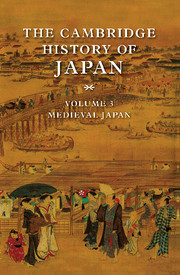Book contents
- Frontmatter
- Introduction
- 1 The Kamakura bakufu
- 2 Medieval shōen
- 3 The decline of the Kamakura bakufu
- 4 The Muromachi bakufu
- 5 Muromachi local government: shugo and kokujin
- 6 The decline of the shōen system
- 7 The medieval peasant
- 8 The growth of commerce in medieval Japan
- 9 Japan and East Asia
- 10 CULTURAL LIFE IN MEDIEVAL JAPAN
- 11 The other side of culture in medieval Japan
- 12 Buddhism in the Kamakura period
- 13 Zen and the gozan
- Works cited
- Glossary
- Index
- References
12 - Buddhism in the Kamakura period
Published online by Cambridge University Press: 28 March 2008
- Frontmatter
- Introduction
- 1 The Kamakura bakufu
- 2 Medieval shōen
- 3 The decline of the Kamakura bakufu
- 4 The Muromachi bakufu
- 5 Muromachi local government: shugo and kokujin
- 6 The decline of the shōen system
- 7 The medieval peasant
- 8 The growth of commerce in medieval Japan
- 9 Japan and East Asia
- 10 CULTURAL LIFE IN MEDIEVAL JAPAN
- 11 The other side of culture in medieval Japan
- 12 Buddhism in the Kamakura period
- 13 Zen and the gozan
- Works cited
- Glossary
- Index
- References
Summary
INTRODUCTION
Buddhism has had a long and illustrious history in Japan, but it was in the Kamakura period that Buddhism in Japan came into full flower. The forms of Buddhism that emerged at that time – Pure Land, Zen, and Nichiren – were largely responsible for the dissemination of Buddhist beliefs and practices throughout Japanese society. The success of this movement lay in tailoring the ideas and goals of Buddhism to the concerns of the populace at large. Hence, Kamakura Buddhism, as the entire religious movement is called, has left an indelible mark on Japanese history and has made Buddhism a lasting and pervasive component of Japanese culture.
Buddhism originated in India and spread to China about four centuries after the time of the historical Buddha Sākyamuni (ca. fifth to fourth century, b.c.). It was transmitted to Japan from China via the Korean peninsula around the middle of the sixth century. The cultural gulf that existed at that time between Japan on the one hand and China and Korea on the other was considerable. Japan's ruling class accepted Buddhism as the embodiment of an advanced and superior civilization, and in order to gain control over the concepts and technology that Buddhism brought to Japan, the elite provided a succession of large temples where Buddhism could put down roots. A community of priests supported by the state and the aristocracy belonged to each of these temples.
Japan absorbed Buddhism as a comprehensive and advanced cultural medium from the outside but did not, at first, give substantial weight to its religious concerns per se.
- Type
- Chapter
- Information
- The Cambridge History of Japan , pp. 544 - 582Publisher: Cambridge University PressPrint publication year: 1990

